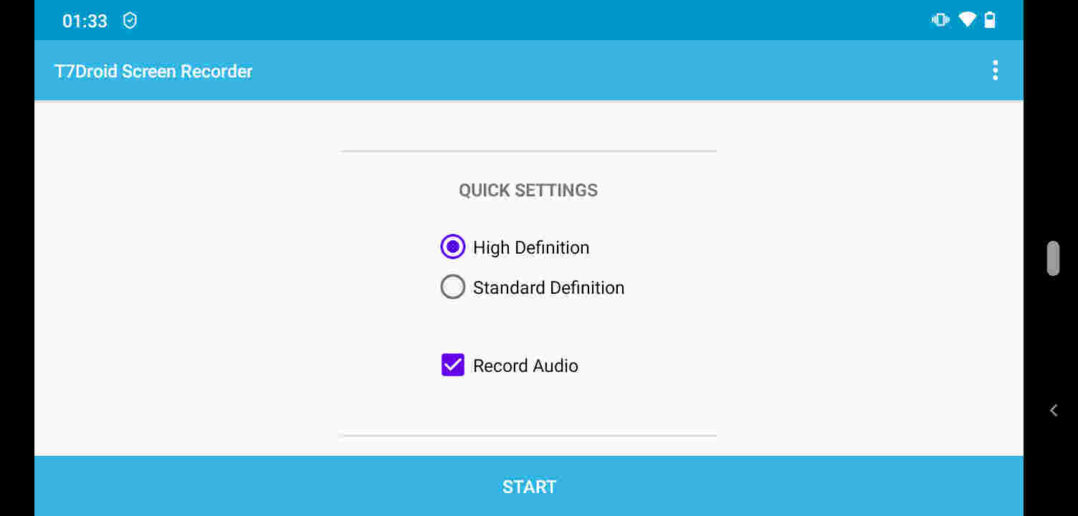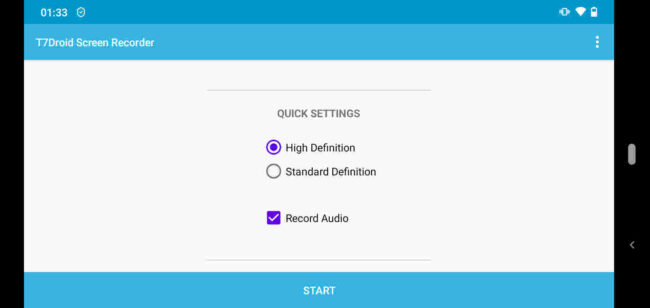Some people may have a bit of confusion as to why a site intended for casual gaming might choose to review something that isn’t, strictly speaking, a game. I promise you there is a justification for it.
Given I am planning to do some Android game reviews, I figured that it would be worth investigating a way of cheaply and easily recording gameplay footage. I was looking at something that was fairly straight-forward and was fairly light on the resource usage. That’s what lead me to investigate whether T7Droid was a suitable option. It seemed to be light-weight, the screenshots on the store page made it look easy enough to use, but flexible enough that I could experiment to get the results I wanted. And being a paid application, it’s not ad-supported.
After a modest investment of $AU0.99, I now have it at my disposal.
Impressions on initial launch
On the intial launch of the app, it wanted to allow a user interface to be visible over other applications. This is a fair enough request. An application of this type would definitely benefit form having it’s user interface easily accessible when recording. I had no hesitation in setting this up.
Once this was set up, the application presented me with a very simple and barebones user interface. I had the option to record in High Definition, Standard Definition, whether to include audio, and the option to use custom settings.
I must applaud the simplicity of this design. This makes it very easy for those who simply want to record their screen without being overwhelmed with a plethora of options that they do not understand, yet also makes it easy for power users to tinker. The only ‘gotcha’ is that once you select custom settings, you need to go into the hamburger menu at the top right to configure those settings. That is really a trivial gripe however. I would much rather this arrangement than one which confuses users who simply want to record their screen with a minimum of fuss.
The settings that you can customise also seem to cover a range of common settings, including video format, resolution, framerate and video bitrate. The only thing that seemed to be missing was the audio bitrate, which would be of use for those wanting to max out the quality for later editing, but the other options seemed to cover just about everything else you could need without being massively overwhelming.
Video Quality
This is where thie magic happens. No matter how simple the applications design, it means nothing if the quality of the recorded footage is not up to expectation.
I have performed a quick test recording of Fruit Ninja 2 and I must say I’m impressed with the video quality. It definitely meets my expectations in terms of quality.
This was also recorded on a Nokia 2.3 running Android 11 which is a spare device I keep on-hand for testing. This is hardly a high-end device by any stretch of the imagination, and aside from a small increase in load time, it didn’t appear to have a major effect on the overall playability. I was actually impressed at how well this device seemed to handle both Fruit Ninja 2 and the screen recording simultaneously. This seems to suggest that T7Droid has been coded to use system resources very efficiently.
The audio quality is not what I expected however. I think it is related to a point I make below, where the device’s microphone is always active when recording, and the substandard quality is caused by the audio from the game being fed back into the device’s microphone. Without the ability to disable the microphone while recording though, I have no way of testing this. Either way, if I want to include audio from the game without including my own narration, this does limit the usefulness of the app.
Technical Issues
While the application itself does its job well, there are a few minor gripes and some pretty damn big one.
One big gripe for me was audio. No matter what audio settings I chose for audio recording, it always seemed to record with the microphone enabled. This is definitely a good option for those that want to narrate their video. However if you’re looking to just record gameplay, or want to add the narration later in post-production, this might be a bit of an issue as for these use cases. If there was one thing I could get fixed, this would be it.
Another interesting quirk is that it does not handle non-standard aspect resolutions. This was uncovered when I was tidying up the test footage above in my video editing package. The test footage was created on a Nokia 2.3, which has a 19:9 aspect ration, and this created some black bars as T7Droid tried to fit that into a more standard 16:9 aspect ratio. This may only be a minot issue for some, as you can fix that via video editing which as you can see from the test footage I’ve been able to do with little difficulty and produced acceptable results. However if you’re wanting to just record the video without the hassle of editing it later, this may be offputting. This could be easily rectified by giving the option of recording at the device’s native aspect ratio as well as 16:9. This does seem to be a glaring omission given the Nokia 2.3 is not the only device to deviate from a 16:9 aspect ratio.
There are a few minor points I would also like to see. Firstly, as mentioned above, there is no ability to set an audio bitrate when recording. This does seem a trivial omission, but you can set video bitrates manually if you desire. Given the lossy nature of most video and audio codecs, it makes sense that you’ll want to set these pretty high if you’re planning to later edit the footage.
The colour scheme also doesn’t seem to be easily changed. The white text on a light blue background might be grating for some. The simple solution might also be to implement dark mode, which seems to be all the rage at the moment, and allow the user to choose which to use. This would allow some flexibility, while trying to maintain the app’s desire to keep things simple.
Conclusion
Where this app shines is in its simplicity, its flexibility and it’s light-weight use of resources. This makes it a great option for those that want an easy-to-use option that works on a variety of devices.
There are a few gripes with the app, but aside from the audio issue and dealing with non-standard aspect ratios, they are all so trivial that they don’t really take anything away from the app’s usage. These may turn some users off, and is something I hope will be rectified in a future update as it is otherwise an extremely good app with a lot of potential..




